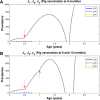How to eliminate taeniasis/cysticercosis: porcine vaccination and human chemotherapy (Part 2)
- PMID: 30803437
- PMCID: PMC6390339
- DOI: 10.1186/s12976-019-0100-x
How to eliminate taeniasis/cysticercosis: porcine vaccination and human chemotherapy (Part 2)
Abstract
Background: The application of effective vaccines against pig cysticercosis and mass chemotherapy against pig cysticercosis and human taeniasis have shown the feasibility of interrupting the parasite's life cycle in endemic areas.
Methods: A mathematical model that divides the population into susceptible, infected, and vaccinated individuals is formulated. The model is based upon the life cycle of the parasite. Computer numerical simulation experiments to evaluate the impact of pig vaccination under different vaccination schedules, and combined intervention strategies including pig vaccination and anthelmintic treatment against human taeniasis are carried out.
Results: Vaccination against either pig cysticercosis or against human taeniasis will influence the transmission dynamics not only among vaccinees but also the dynamics of the other hosts as well. When the protective efficacy and/or the coverage rate is less than 100%, different mass interventions like vaccinating the pig population twice in combination with chemotherapeutic treatment against human taeniasis, the elimination of the infection in both pigs and humans can also be achieved.
Conclusions: Our mathematical model has the potential for planning, and designing effective intervention strategies including both mass vaccination and/or chemotherapeutic treatment to eliminate pig cysticercosis, human taeniasis and human neurocysticercosis. The model can be adapted to any given community with mild, moderate endemicity, or even in hyperendemic regions.
Keywords: Chemotherapeutic interventions; Computer simulation experiments; Elimination; Eradication; Public health; Susceptible-infected mathematical model; Taenia-cysticercosis; Vaccination strategies.
Conflict of interest statement
Authors’ information
NYS is a PhD student of Biomedical Sciences in the Theoretical Biology Group. JRB is Academic Technician of the Theoretical Biology Group; MVJ is Full Professor and Head of the Theoretical Biology Group; JPL is Full Professor in the Department of Immunology.
Ethics approval and consent to participate
Not applicable.
Consent for publication
This study does not contain any individual person’s data in any form.
Competing interests
The authors declare that they have no competing interests.
Publisher’s Note
Springer Nature remains neutral with regard to jurisdictional claims in published maps and institutional affiliations.
Figures






Similar articles
-
Mathematical model of the life cycle of taenia-cysticercosis: transmission dynamics and chemotherapy (Part 1).Theor Biol Med Model. 2018 Nov 19;15(1):18. doi: 10.1186/s12976-018-0090-0. Theor Biol Med Model. 2018. PMID: 30449280 Free PMC article.
-
Assessing the impact of intervention strategies against Taenia solium cysticercosis using the EPICYST transmission model.Parasit Vectors. 2017 Feb 9;10(1):73. doi: 10.1186/s13071-017-1988-9. Parasit Vectors. 2017. PMID: 28183336 Free PMC article.
-
Control of Taenia solium taeniasis/cysticercosis: from research towards implementation.Int J Parasitol. 2005 Oct;35(11-12):1221-32. doi: 10.1016/j.ijpara.2005.07.015. Int J Parasitol. 2005. PMID: 16143335 Review.
-
Why pigs are free-roaming: Communities' perceptions, knowledge and practices regarding pig management and taeniosis/cysticercosis in a Taenia solium endemic rural area in Eastern Zambia.Vet Parasitol. 2016 Jul 30;225:33-42. doi: 10.1016/j.vetpar.2016.05.029. Epub 2016 May 24. Vet Parasitol. 2016. PMID: 27369573
-
Overview of Taenia solium cysticercosis in West Africa.Acta Trop. 2019 Feb;190:329-338. doi: 10.1016/j.actatropica.2018.12.012. Epub 2018 Dec 7. Acta Trop. 2019. PMID: 30529447 Review.
Cited by
-
Optimal control analysis of Taenia saginata bovine cysticercosis and human taeniasis.Parasite Epidemiol Control. 2021 Dec 31;16:e00236. doi: 10.1016/j.parepi.2021.e00236. eCollection 2022 Feb. Parasite Epidemiol Control. 2021. PMID: 35028439 Free PMC article.
-
The World Health Organization 2030 goals for Taenia solium: Insights and perspectives from transmission dynamics modelling: CystiTeam Group for Epidemiology and Modelling of Taenia solium Taeniasis/Cysticercosis.Gates Open Res. 2019 Sep 26;3:1546. doi: 10.12688/gatesopenres.13068.2. eCollection 2019. Gates Open Res. 2019. PMID: 31701092 Free PMC article.
-
CystiHuman: A model of human neurocysticercosis.PLoS Comput Biol. 2022 May 19;18(5):e1010118. doi: 10.1371/journal.pcbi.1010118. eCollection 2022 May. PLoS Comput Biol. 2022. PMID: 35587497 Free PMC article.
-
Taenia solium Cysticercosis and Its Impact in Neurological Disease.Clin Microbiol Rev. 2020 May 27;33(3):e00085-19. doi: 10.1128/CMR.00085-19. Print 2020 Jun 17. Clin Microbiol Rev. 2020. PMID: 32461308 Free PMC article. Review.
-
Modelling for Taenia solium control strategies beyond 2020.Bull World Health Organ. 2020 Mar 1;98(3):198-205. doi: 10.2471/BLT.19.238485. Epub 2020 Jan 27. Bull World Health Organ. 2020. PMID: 32132754 Free PMC article.
References
-
- Grove DI. A History of Human Helminthology. Wallingford: C·A·B International; 1990. p. 848.
-
- World Health Organization. Neglected Tropical Diseases. 2012. https://www.who.int/neglected_diseases/diseases/en/. Accessed Jan 2018.
Publication types
MeSH terms
Substances
LinkOut - more resources
Full Text Sources
Medical

